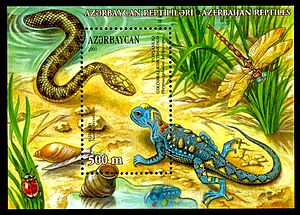Persian toad-headed agama facts for kids
Quick facts for kids Persian toad-headed agama |
|
|---|---|
 |
|
| Conservation status | |
| Scientific classification | |
| Genus: |
Phrynocephalus
|
| Species: |
persicus
|
| Synonyms | |
|
|
The Phrynocephalus persicus, also known as the Persian toad-headed agama, is a small lizard. It lives in deserts and is active during the day. This lizard belongs to the Agamidae family. It is found in the deserts and semi-deserts of Iran. It might also live in Azerbaijan. It is the most western type of a group of lizards called toad-headed agamas.
Contents
About the Persian Toad-Headed Agama
Lizard Family Tree
Scientists are still learning about the Phrynocephalus group of lizards. It is a bit tricky to figure out how they are all related. There is also some debate about whether certain types are full species or just subspecies. This group is sometimes called the "helioscopus-persicus complex."
Different Types of Persian Agamas
There is an ongoing discussion about the Phrynocephalus persicus. Recent studies suggest there might be at least two different types. One is the Persian toad-headed agama (Phrynocephalus persicus persicus). It lives in northern and central Iran. The other is Horvath's toad-headed agama (Phrynocephalus persicus horvathi). This one is found in Armenia, Azerbaijan, northwest Iran, and northeast Turkey.
The IUCN (International Union for Conservation of Nature) sees them as two separate species. They list P. persicus as Vulnerable. This means it is at risk of becoming endangered. Phrynocephalus horvathi is listed as Critically Endangered. This means it is at a very high risk of disappearing.
What Does It Look Like?
Size and Appearance
Newborn Persian toad-headed agamas are about 2.3 centimeters (about 1 inch) long. They weigh around 0.4 grams. Adults can grow up to 7 centimeters (about 2.7 inches) long. They can weigh up to 7.8 grams.
Males and females look a bit different. This is called sexual dimorphism. Females are usually a little bigger than males. The P. persicus also seems to have a shorter tail than P. horvathi.
Special Features
Like its relatives, this lizard does not have visible ear-drums. Its head and body are wide. They are covered with many small scales. It does not have a large shield on its head like some other lizards.
Colors and Patterns
The lizard's color helps it hide. This is called cryptic coloration. Its colors usually match the sand or dirt around it. This makes the lizard almost impossible to see. It has scales of different sizes, shapes, and colors. These create a mosaic pattern. This pattern helps the lizard blend in with sandy ground.
Some scales are cone-shaped. They form dark spots that are spread out evenly. The back of the lizard has dark dots in rows. These form clear dark areas on its shoulders and lower back. The middle of its back might have one to three groups of dark spots. Sometimes, it has no pattern there at all.
Color Changes
There are usually two or three long red areas on its neck. These are surrounded by blue. The color of these spots can show if a female is pregnant. When a female is pregnant, the red color turns bluish-grey. These areas then become blue.
The lizard's belly is white. It has a bright orange color near its tail. The tail usually has dark and white stripes. The underside of the tail is dark grey in males from Armenia. It is yellowish in females from Armenia.
Where Does It Live?
Habitat and Location
The Persian toad-headed agama lives in small, separate groups. These groups are found in the northwestern and western parts of Iran's Central Plateau. There have been reports of it in Azerbaijan. However, these reports have not been confirmed in the last 50 years.
This lizard lives in semi-desert areas. These are often on plateaus up to 1,150 meters (about 3,770 feet) high.
Life Cycle and Habits
Life Span and Diet
The P. persicus usually lives for 2.5 to 3 years. Young lizards become adults in less than one year. This species eats many different arthropods. These include ants, small spiders, beetles, and grasshoppers. It can even eat venomous arthropods like spiders, bees, and wasps.
Reproduction
The P. persicus is oviparous. This means the female lays eggs to have babies. A female can lay one to three groups of eggs. Each group has two to four small eggs. The number of egg groups depends on how long the warm season lasts. This also depends on how high up the land is.
The female digs a narrow burrow in the sand. It is about 30 centimeters (about 1 foot) deep. She lays her eggs inside this burrow. When a female is pregnant, she acts very protective. She can be aggressive towards other lizards or animals that come near. This behavior includes walking on her back legs with her belly puffed out. She might also wave her tail around. She can even make marks on the sand with her tail. Sometimes, she will open her mouth to attack.
Protecting the Species
Conservation Status
The Persian toad-headed agama is quite common in places where it can live. However, its populations are spread out in patches. The IUCN currently lists it as Vulnerable.
Threats to the Lizard
The areas where this lizard lives often overlap with places where humans use the land a lot. This means that losing their habitat is a big problem. Other threats include too much grazing by livestock. Also, people sometimes collect them without control. Lizards can also be hit by cars on roads. Larger animals sometimes hunt them.
The lizard's habitats are now like small islands of semi-desert. These are surrounded by farmlands. Scientists have had good results breeding P. horvathi in zoos. However, there are no stable groups of P. persicus being bred in captivity yet.


